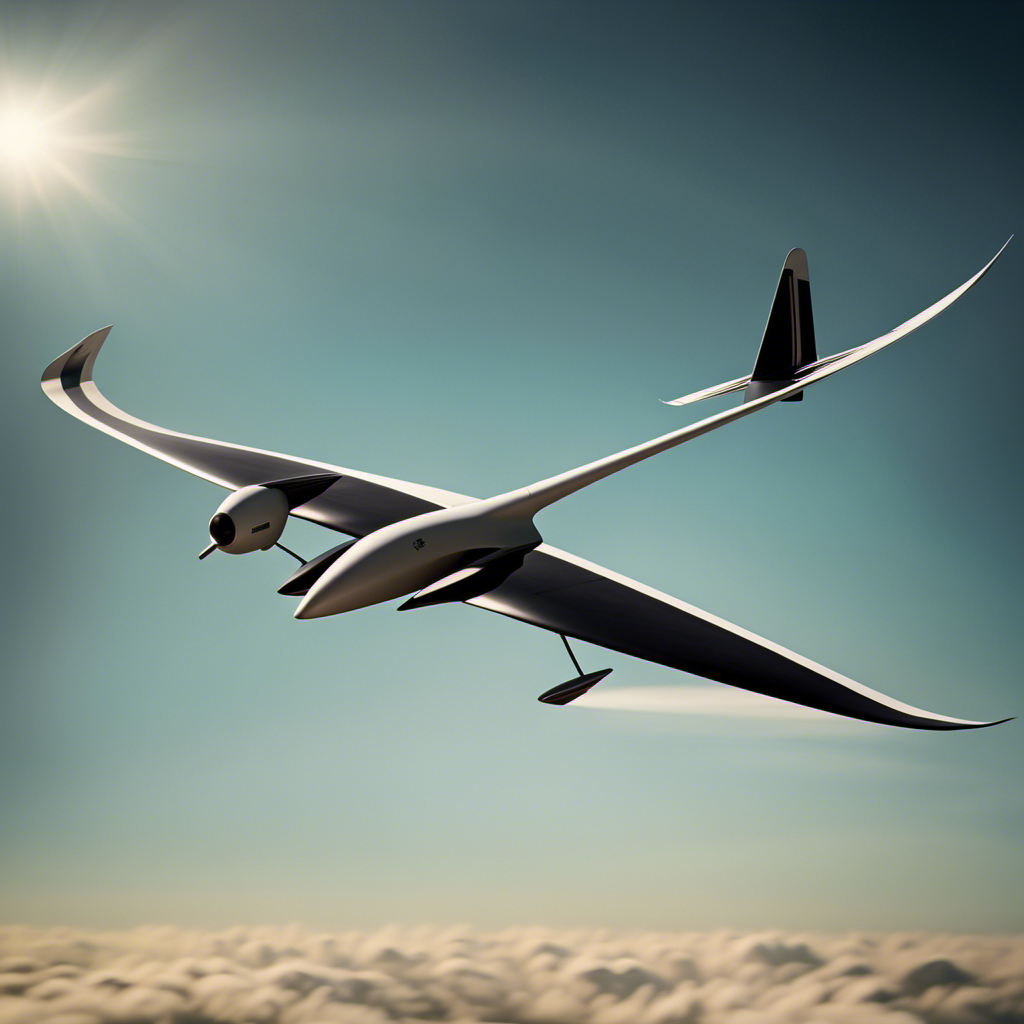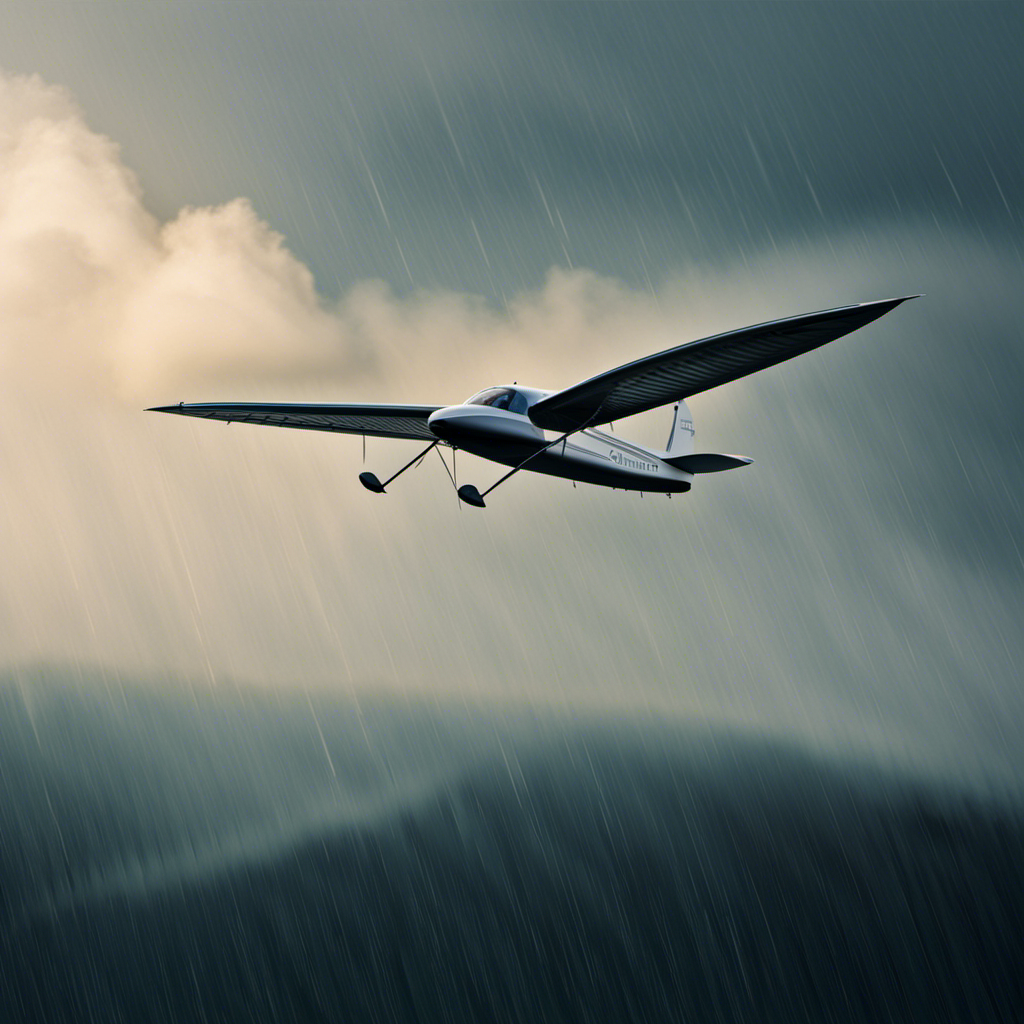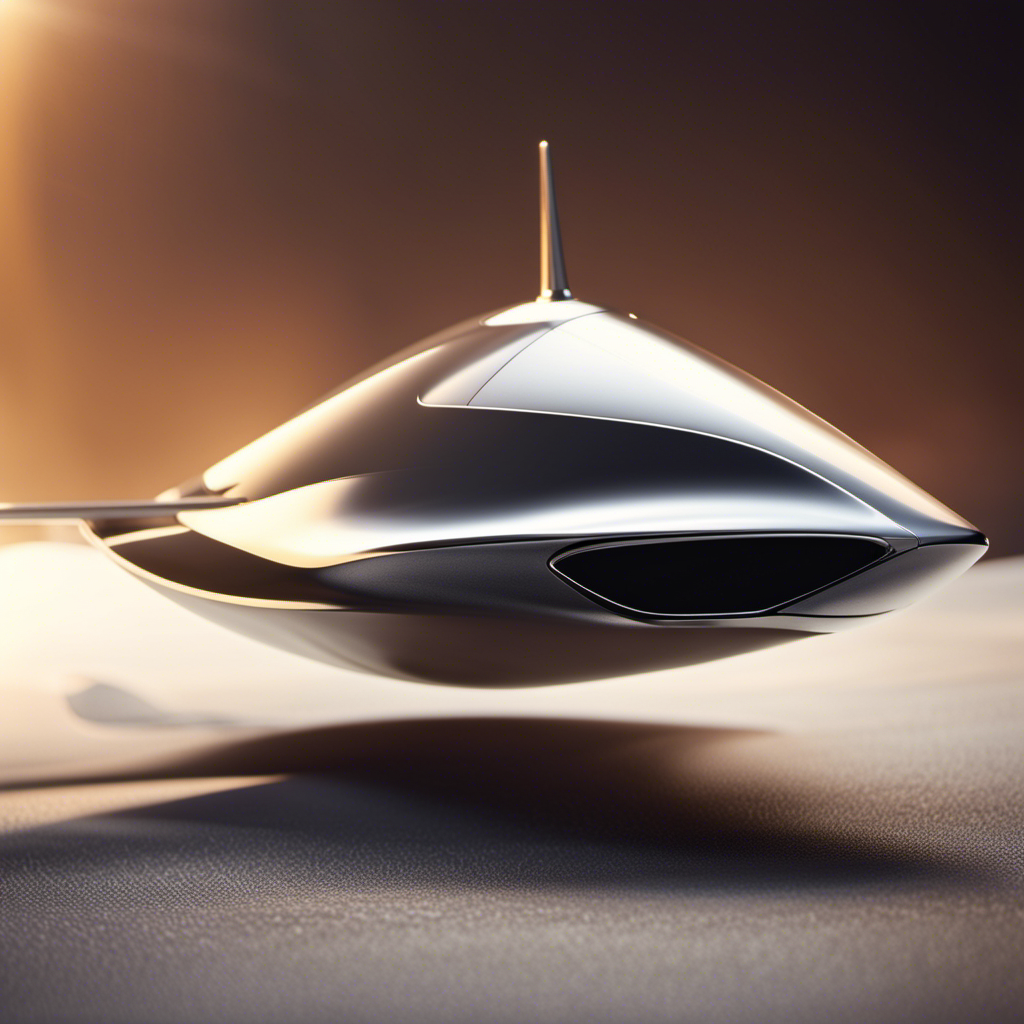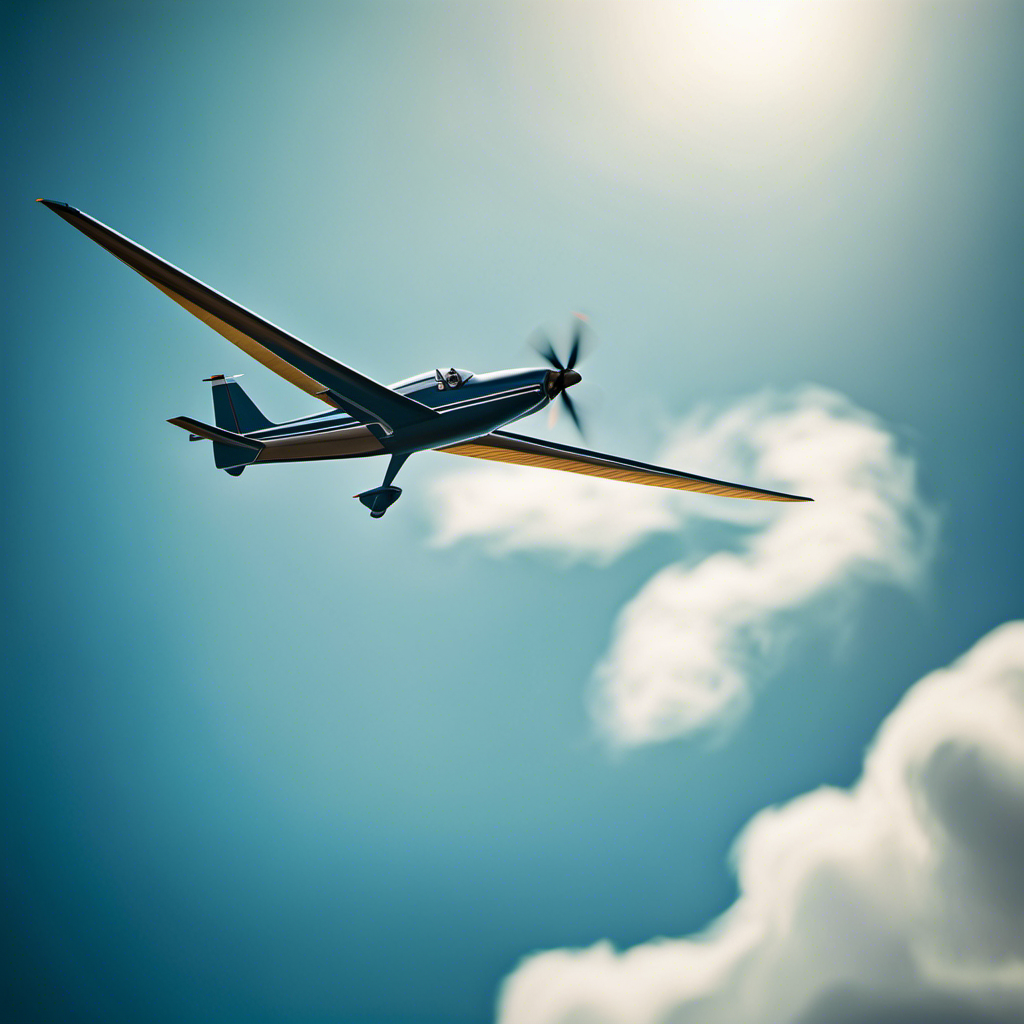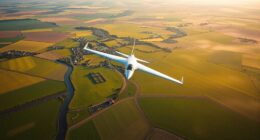Did you know that gliders are able to perform precise maneuvers in the air even without engines? The key to this precise control is the air brake.
In this article, I will delve into the world of glider flight dynamics and explore the role of air brakes in these unique aircraft. We will examine the basics of glider design, the purpose of air brakes, and the training and techniques required to effectively use them.
Join me as we uncover the fascinating world of glider air brakes.
Key Takeaways
- Air brakes are crucial for safe and efficient glider flight operations.
- Different types of air brakes, such as spoilers and flaps, have unique characteristics and advantages.
- Pilots require training to effectively use air brakes and must understand their impact on glider performance.
- Air brakes allow precise speed adjustments, enhance maneuverability, and improve overall flight dynamics in gliders.
Understanding Glider Flight Dynamics
Do you understand how glider flight dynamics work?
As a pilot, it is crucial to have a deep understanding of glider performance and the factors that influence it. Glider flight dynamics refer to the science behind how gliders fly and maneuver through the air. It involves studying the forces acting on the glider, such as lift, drag, weight, and thrust. Understanding these principles allows pilots to make informed decisions during flight, optimizing their glider’s performance.
By analyzing the glider’s weight and balance, wing design, and airfoil characteristics, pilots can predict how the glider will behave in different flight conditions. This knowledge is essential for safe and efficient glider operations.
Now, let’s delve into the role of air brakes in aircraft, a crucial aspect of glider flight control.
The Role of Air Brakes in Aircraft
Air brakes play a crucial role in controlling the speed and descent of aircraft. In glider design, air brake mechanisms are essential for maintaining control during flight. These mechanisms are typically located on the wings and are used to increase drag, reducing the glider’s forward speed.
By deploying the air brakes, pilots can effectively control the rate of descent and adjust their flight path. There are various techniques for deploying air brakes, depending on the glider model and design. Some gliders have manual controls, allowing pilots to adjust the air brake position manually. Others may have automatic systems that deploy the air brakes based on predetermined conditions, such as airspeed or altitude.
Understanding the function and deployment techniques of glider air brakes is crucial for safe and efficient flight.
Now, let’s delve into the basics of glider design.
The Basics of Glider Design
Glider design involves incorporating various techniques and mechanisms to ensure safe and efficient flight. The design process takes into consideration the principles of glider flight dynamics, which include lift, drag, weight, and thrust. By understanding these factors, designers can create gliders that maximize performance and optimize their ability to stay aloft for extended periods of time.
One important aspect of glider design is the use of control surfaces. These surfaces, such as ailerons, elevators, and rudders, allow the pilot to control the glider’s movement and maneuverability. By manipulating these control surfaces, the pilot can adjust the glider’s roll, pitch, and yaw.
To better understand the role of control surfaces in gliders, let’s take a look at the following table:
| Control Surface | Function |
|---|---|
| Ailerons | Control roll |
| Elevators | Control pitch |
| Rudders | Control yaw |
| Spoilers | Reduce lift and increase drag |
| Flaps | Increase lift and drag |
As we delve into the section about control surfaces in gliders, we will explore how these mechanisms contribute to the overall flight dynamics and maneuverability of gliders.
Control Surfaces in Gliders
The control surfaces in gliders, such as ailerons, elevators, and rudders, allow me as a pilot to manipulate the glider’s movement and maneuverability. By understanding the glide ratio and the impact of these control surfaces, I can effectively control the glider’s flight path and optimize its performance.
Ailerons, located on the wings, control the roll of the glider, enabling me to bank left or right. Elevators, located on the tail, control the pitch, allowing me to raise or lower the nose. Rudders, also on the tail, control the yaw, enabling me to turn left or right. These control surfaces work together to give me precise control over the glider’s movements.
Now, let’s explore the purpose of air brakes in gliders, which play a crucial role in controlling the glider’s descent.
The Purpose of Air Brakes in Gliders
Using air brakes in a glider helps to control its descent and maintain a steady rate of descent. Air brake mechanisms are crucial components that play a significant role in glider performance. Here are three key aspects of air brakes in gliders:
-
Increase Drag: When the air brakes are deployed, they create additional drag, which slows down the glider’s forward motion. This helps to control the rate of descent and prevent the glider from descending too quickly.
-
Stability: Air brakes provide stability during descent by ensuring a consistent rate of descent. They allow the pilot to adjust the glider’s speed and altitude with precision, ensuring a safe and controlled descent.
-
Reduced Landing Distance: By using air brakes effectively, glider pilots can reduce their landing distance. The increased drag generated by the air brakes helps to slow down the glider, allowing for a smoother and shorter landing.
Understanding the impact of air brakes on glider performance is essential for safe and efficient flying. In the next section, we will explore the different types of air brakes in gliders, each with its unique characteristics and advantages.
Different Types of Air Brakes in Gliders
To understand the different types of air brakes in gliders, you’ll find that each type has its own unique characteristics and advantages. Air brakes are essential in gliders to control their descent rate and reduce speed during landing.
There are three main types of air brakes commonly used in gliders: spoilers, dive brakes, and flaps.
Spoilers are panels located on the upper surface of the wing that disrupt the airflow, creating drag and reducing lift. They are highly effective in quickly decreasing the glider’s speed and descent rate.
Dive brakes, on the other hand, are surfaces that can be extended from the fuselage or wings to increase drag and reduce speed. They are particularly useful during steep descents or in emergency situations.
Lastly, flaps are devices on the trailing edge of the wing that increase the wing area, thereby increasing drag and allowing for steeper descents. They also help with maintaining control during landings.
Each type of air brake has its advantages, and glider pilots can select the most suitable one depending on the flight conditions and desired outcome.
Transitioning to the subsequent section about spoilers as air brakes in gliders, spoilers are widely used and offer several benefits in terms of performance and safety.
Spoilers as Air Brakes in Gliders
Moving on from discussing the various types of air brakes in gliders, let’s now focus on spoilers as air brakes.
Spoilers are small plates located on the upper surface of the wing that can be raised to disrupt the smooth airflow and create drag, thus reducing the glider’s speed. This method of speed control offers several advantages.
Firstly, spoilers are highly efficient in slowing down the glider, allowing pilots to quickly adjust their descent rate.
Secondly, spoilers provide an alternative speed control option when other methods, such as flaps, are not available or not sufficient. By utilizing spoilers as air brakes, pilots can precisely manage their glider’s speed during critical phases of flight.
Now, let’s delve into the next section and explore the use of flaps as air brakes in gliders.
Flaps as Air Brakes in Gliders
Flaps, also known as spoilers, are a crucial component of glider aerodynamics. They can be deployed on gliders to increase drag and reduce speed during descent. When the flaps are extended, they disrupt the smooth airflow over the wings, creating a significant increase in drag. This drag force acts as an air brake, slowing down the glider and allowing for a controlled descent.
To give you a clear picture, imagine a glider with flaps deployed for speed control:
- The flaps extend upwards from the wings, disrupting the airflow and creating drag.
- The glider descends at a controlled rate, thanks to the increased drag.
- The pilot adjusts the angle of the flaps to fine-tune the descent speed.
- As the glider nears the landing zone, the flaps are gradually retracted to regain lift and prepare for landing.
While flaps are commonly used as spoilers for speed control, there are other methods available that offer alternative ways to regulate the glider’s velocity.
Other Methods of Speed Control in Gliders
Another way to control the speed of gliders is by adjusting the angle of the wings. Understanding glider aerodynamics is crucial in comprehending how this method works.
By changing the angle of attack, which is the angle between the wing’s chord line and the relative wind, the lift and drag forces acting on the glider can be altered. When the angle of attack is increased, the lift force increases, allowing the glider to climb. Conversely, when the angle of attack is decreased, the lift force decreases, causing the glider to descend.
This method of speed control is directly influenced by the weight of the glider. Heavier gliders require larger changes in the angle of attack to achieve the desired speed adjustments.
Transitioning into the subsequent section, the effectiveness of air brakes in gliders is another important aspect of speed control.
The Effectiveness of Air Brakes in Gliders
The effectiveness of air brakes in gliders can greatly impact the control of speed. Air brakes are an essential component of glider design, providing pilots with a reliable method to adjust their speed during flight.
Unlike other methods of speed control, such as spoilers or flaps, air brakes allow for precise and immediate adjustments to the glider’s velocity. This is achieved by increasing the drag on the glider, which effectively slows it down.
The advantages of using air brakes are numerous. Firstly, they are highly effective in reducing speed, allowing pilots to safely navigate through various weather conditions and airspace restrictions. Additionally, air brakes are easy to operate and provide a consistent and predictable response, making them a reliable tool for glider pilots.
Understanding the effectiveness and advantages of air brakes is crucial in ensuring the safe operation of gliders.
The Role of Air Brakes in Glider Safety
When properly utilized, air brakes play a crucial role in ensuring the safety of gliders. Understanding air brake mechanisms is essential for optimizing air brake performance.
Air brakes are designed to create drag and reduce the speed of the glider during descent. They consist of flaps that are extended from the wings, increasing the surface area and creating more drag. By manipulating the position of the air brakes, pilots can control the rate of descent and maintain a safe and controlled landing.
It is important for glider pilots to have a thorough understanding of how air brakes work and how to use them effectively. By mastering the techniques and training required for using air brakes, pilots can enhance their safety and ensure smooth landings without the need for additional steps or procedures.
Training and Techniques for Using Air Brakes
To effectively utilize air brakes, you should focus on mastering the techniques and training required for optimal performance. Here are three key training techniques that can enhance air brake performance:
-
Proper positioning: Understanding the correct positioning of the air brakes is crucial. This involves knowing when and how much to extend or retract them during flight.
-
Smooth operation: Smoothly operating the air brakes is essential to avoid sudden changes in speed or altitude. This requires practicing controlled and gradual movements.
-
Coordination with other controls: Coordinating the use of air brakes with other flight controls, such as the elevator and ailerons, is vital for maintaining stability and controlling the glider’s descent.
Limitations and Considerations for Air Brakes in Gliders
Coordinating the use of air brakes with other flight controls, such as the elevator and ailerons, is crucial for maintaining stability and controlling the glider’s descent. However, there are certain limitations and considerations that pilots must keep in mind when using air brakes in gliders.
Firstly, the effectiveness of air brakes can be influenced by factors like wind conditions, airspeed, and aircraft weight. Pilots need to be aware of these variables to ensure the air brakes are used appropriately.
Additionally, it’s important to consider the impact of air brake deployment on the glider’s aerodynamics and performance. Sudden or excessive use of air brakes can lead to a loss of lift and an increased rate of descent. Therefore, pilots must exercise caution and judgment when using air brakes to maintain safe and controlled flight.
Transitioning to advancements in glider air brake technology, innovative designs and materials have been developed to enhance the effectiveness and efficiency of air brakes without compromising the glider’s performance.
Advancements in Glider Air Brake Technology
After discussing the limitations and considerations for air brakes in gliders, it is important to explore the advancements in glider air brake technology.
Over the years, researchers and engineers have made significant progress in improving the effectiveness and efficiency of air brakes in gliders. These advancements have been driven by a deeper understanding of aerodynamics and the need for enhanced control during glider flights.
One major advancement is the development of variable geometry air brakes, which allow for precise control of the braking force. By adjusting the position and angle of the air brake surfaces, pilots can fine-tune their descent rate and maintain optimal glide ratios.
Additionally, the use of computer models and simulations has greatly facilitated the design and optimization of air brake systems.
Conclusion: The Importance of Air Brakes in Gliders
The advancements in glider air brake technology have greatly improved the safety and performance of flights. The impact of air brakes on glider performance cannot be overstated. Here are three key ways in which air brakes have revolutionized gliding:
-
Enhanced control: Air brakes provide pilots with increased control over their gliders during flight. By adjusting the position of the air brakes, pilots can manipulate the glider’s lift and drag, allowing for precise maneuvering and increased safety.
-
Improved landing techniques: Air brakes play a crucial role in the landing process. By deploying the air brakes, pilots can reduce the glider’s speed and altitude, enabling a smoother and safer landing. This has significantly reduced the risk of accidents and enhanced overall landing techniques.
-
Increased glide ratio: Air brakes have also contributed to the improvement of glider performance by enhancing the glider’s glide ratio. By utilizing the air brakes to adjust the glider’s lift and drag, pilots can optimize the efficiency of the glide, resulting in longer flight times and increased distance covered.
Frequently Asked Questions
How do gliders slow down without using air brakes?
To slow down without using air brakes, gliders utilize flap deployment and weight shifting techniques. Flaps are extended to increase drag and reduce lift, while weight shifting involves shifting the pilot’s body to change the glider’s center of gravity and induce drag.
Are air brakes the only method of speed control in gliders?
Air brakes are not the only method of speed control in gliders. Alternative speed control methods include spoilers, flaps, and weight shifting. However, the impact of air brake usage on glider performance should be considered.
Can gliders still fly safely without air brakes?
Yes, gliders can fly safely without air brakes. While air brakes are a common method of speed control, alternative methods such as spoilers and flaps can also be used. The impact of air brake technology on glider performance is significant.
What are the limitations of using air brakes in gliders?
The limitations of using air brakes in gliders include increased drag and reduced glide performance. Alternatives to air brakes include spoilers, which can be more effective in controlling descent rates while minimizing drag.
Are there any advancements in air brake technology for gliders?
Advancements in glider technology have led to significant improvements in air brake systems. These advancements include the development of more efficient and aerodynamic air brake designs, as well as the incorporation of advanced materials for enhanced performance and reliability.
Conclusion
In conclusion, air brakes play a crucial role in enhancing the safety and control of gliders. These devices, like a well-oiled machine, allow glider pilots to manipulate the aircraft’s flight characteristics with precision and finesse.
By creating drag and reducing lift, air brakes enable gliders to descend rapidly and maintain a desired glide path. As technology advances, so too does the sophistication of glider air brakes, offering pilots even greater control and maneuverability in their soaring endeavors.
So remember, when it comes to gliders, air brakes are the wind beneath their wings.
